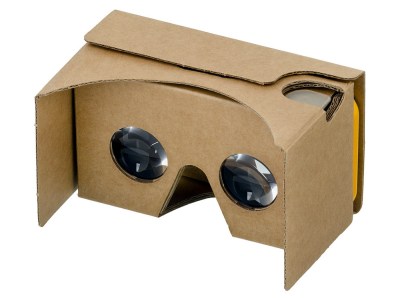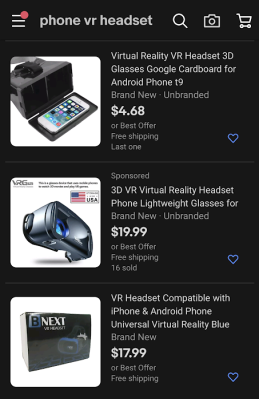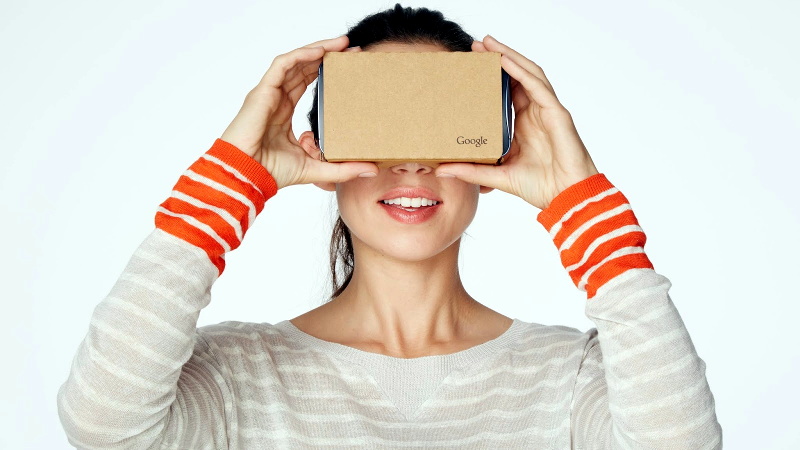Google giving up on one of their projects and leaving its established userbase twisting in the wind hardly counts as news anymore. In fact, it’s become something of a meme. The search giant is notorious for tossing out ideas just to see what sticks, and while that’s occasionally earned them some huge successes, it’s also lead to plenty of heartache for anyone unlucky enough to still be using one of the stragglers when the axe falls.
So when the search giant acknowledged in early March that they would no longer be selling their Cardboard virtual reality viewer, it wasn’t exactly a shock. The exceptionally low-cost VR googles, literally made from folded cardboard, were a massive hit when they were unveiled back in 2014. But despite Google’s best efforts to introduce premium Cardboard-compatible hardware with their Daydream View headset two years later, it failed to evolve into a profitable business.

Of course if you knew where to look, the writing had been on the wall for some time. While the Daydream hardware got a second revision in 2017, and Google even introduced a certification program to ensure phones would work properly with the $100 USD headset, the device was discontinued in 2019. On the software side, Android 7 “Nougat” got baked-in VR support in 2016, but it was quietly removed by the time Android 11 was released in the fall of 2020.
With Cardboard no longer available for purchase, Google has simply made official what was already abundantly clear: they are no longer interested in phone-based virtual reality. Under normal circumstances, anyone still using the service would be forced to give it up. Just ask those who were still active on Google+ or Allo before the plug was pulled.
But this time, things are a little different. Between Google’s decision to spin it off into an open source project and the legions of third party viewers on the market, Cardboard isn’t going down without a fight. The path ahead might be different from what Google originally envisioned, but the story certainly isn’t over.
The Case For Cheap VR
Clearly Google was cooling on the idea of phone-based VR for some time, but their exit from the market was further accelerated by the arrival of new stand-alone VR headsets from the likes of Oculus that far outperformed Cardboard. But not all consumers saw this as a step forward. While the new VR headsets were undoubtedly impressive, they were also expensive and introduced new software ecosystems that many users were reluctant to buy into. There’s still a market for cheap headsets that allow smartphones to be used for rudimentary VR, but it simply isn’t lucrative enough to entice a company like Google.
 Of course not all companies have such high standards. Despite the considerable limitations of smartphone VR, there’s no shortage of Cardboard-like headsets available for consumers to chose from. They range from cheap toy store fodder to more advanced units that try to deliver the high-end experiences Google offered with their own Daydream Viewers.
Of course not all companies have such high standards. Despite the considerable limitations of smartphone VR, there’s no shortage of Cardboard-like headsets available for consumers to chose from. They range from cheap toy store fodder to more advanced units that try to deliver the high-end experiences Google offered with their own Daydream Viewers.
A quick search on Amazon or eBay returns a seemingly unending string of VR headsets for every possible budget or application; all relying on nothing more than the smartphone you already bought and paid for. It’s easy to look at these headsets, many coming from fly-by-night companies, and see them as cheap clones looking to capitalize on Google’s idea. But the reality is, the Cardboard viewer specification was always intended to be open source.
Even if most manufacturers decided not to take the literal cardboard route that Google pioneered, the general layout of the viewer and the best practices outlined in the accompanying documentation were an invaluable base to work from. It didn’t take these companies long to adapt the basic Cardboard premise into a rigid plastic frame, and from there, start layering on new features and capabilities to set themselves apart from the competition.
Can a $5 USD plastic box with shoddy lenses compete on a technological level with stand-alone VR headsets, to say nothing of the models that use a gaming PC to provide the visuals? Of course not. But that’s hardly the point. Outfitted with a second-hand phone, these low-cost devices can deliver immersive 360° visuals at a fraction of the price. That means bringing VR to people and places that otherwise never would have had access to the technology.
Software for Seeing Double
While the state-of-the-art might not evolve much beyond where it is currently, Cardboard derived VR headsets aren’t going away anytime soon. Of course, the hardware is only one half of the equation. With the VR functionality already stripped from the latest release of Android, what will users actually be able to use these devices for?
 The good news is that while Android might have lost its native VR capabilities, they were never terribly important in the first place. Achieving a basic stereoscopic effect is as easy as displaying two viewpoints on the screen at once and letting the optical properties of the headset handle the rest. It’s a simple enough trick that can even be pulled off with an
The good news is that while Android might have lost its native VR capabilities, they were never terribly important in the first place. Achieving a basic stereoscopic effect is as easy as displaying two viewpoints on the screen at once and letting the optical properties of the headset handle the rest. It’s a simple enough trick that can even be pulled off with an ffmpeg filter, and certainly doesn’t require any operating system level optimizations. Especially given the ever-increasing computational power of the average smartphone.
But as it so happens, Google has also released the Cardboard SDK as an open source project. This allows developers to create cross-platform VR experiences for Android and iOS, and provides functions for motion tracking and stereoscopic rendering. The official roadmap shows there are plans to continue development of the SDK, though it’s worth noting no commits have been made since December of 2020. That said there are a number of active forks of the project, so even if Google is no longer actively contributing, the community seems willing to keep pushing the SDK ahead for the time being.
Pioneering Responsibly
Google has rightly caught a lot of flack in the past for abandoning products without giving them a chance to succeed, or worse, killing a product off without having an exit plan in place, but it’s hard to find fault in how they’ve decided to wind down Cardboard. We could debate why they were unable to monetize the concept of phone-based VR, especially with public interest being so high, but it’s a moot point. The important thing is that the community was given unfettered access to the Cardboard hardware and software once Google decided they couldn’t make money off of the idea.
Ultimately, Google’s handling of Cardboard is a fantastic example of innovation done right. Tech companies will always engage in this sort of speculative development in pursuit of the next best thing, and invariably, many of those ideas will fail to become profitable. Instead of locking up all that research and development where no one can access it, we should encourage companies that take the noble route of open sourcing their harebrained schemes. Just because they couldn’t figure out how to make it profitable doesn’t mean we can’t figure out how to make it work.















Maybe they should have gone the Microchannel route once they lost control of the “making money” route.
The only use I’ve had for my phone VR setup has been revisiting vacation spots. It really is awesome to come back from vacation with a ton of 360 picture sets and be able to relive being there. Not to mention when friends come over and ask “how was it?” and I go “See it for yourself!” There is not way to describe their awe.
The other thing I like to do from time to time is go on virtual tours. We’ve been stuck in the house for a year, but I’ve been all over the world thanks to being able to use my phone for VR.
Other than that, never really cared for the tech.
Other than that! I think they missed an opportunity to promote it once again during the pandemic, would seem to be the perfect time, especially with some Youtube tie ins to vacation spots, concerts, etc.
If this review is something you “never really cared for”, I can’t imagine how you must feel about something you actually like…
Google? Userbase?
You sure you aren’t confusing “users” with “products”?
Google users == advertisers; perhaps spy agencies, who knows.
Google products == you, me, the rest of us.
“PIONEERING RESPONSIBLY” is a bit of a stretch to describe Google, maybe more like: “You were so much less evil this time, I’m so proud of you.”
They are certainly not the first to release the source code to their abandon-ware, and just because they didn’t screw people over as much as last time doesn’t make this a good thing. For a company that claimed “Don’t be evil” as a value, we sure hold it to a low standard.
Also let’s not forget Google’s approach to “PIONEERING RESPONSIBLY” in the field of AI Ethic.
Cardboard was/is a pretty cool tech demo, and apparently a lucrative business for companies that aren’t Google: just look at the sheer number of companies selling “phone holder” VR headsets. (At this point the fact Google isn’t making them anymore is almost immaterial.) Certainly the Quest 2 blows it out of the water in quality, but can’t come close in the access department: it might not be great VR, but it is immersive media.
It still feels important to me. My day job involves working on an open source OpenXR runtime (for running VR apps), and it feels important enough to me that I’m still working to have our Android support usable with Cardboard-class slide in headsets. It’s not there yet, but my goal is that anybody with a Cardboard or similar headset should be able to run the same OpenXR apps that you can run on a Quest or another vendor’s all in one. Sure, it won’t be as good of an experience, but it will be something, and a lot cheaper (and larger installed base) than a Quest. Certainly good enough for some things, and hopefully works to keep VR development open and not limited to those with a few hundred dollars and a eula signature to throw at Facebook.
That sounds awesome. I’ll check out OpenXR and look forward to seeing Cardboard support.
I managed to not actually mention the name of the project: while OpenXR is the standard, Monado is the open source project implementing it that will eventually have cardboard support. (Other headsets like the Quest and most desktop headsets now support OpenXR, but their runtime/drivers only work on their hardware.)
Looks like Google didn’t spy enough on customers to know what they want.
Are there any 3D printed goggle designs out there? I was looking at getting cardboard ones but they seem a bit pricey for what they are (I’m sure they used to be only £1)
Actually forget that! I just spotted the Homido Mini design.
I can buy a set of 4.5 dioptre reading glasses for a pound, and print a bracket, job done!
Reading glasses! I’ve been casually messing about with Cardboard for a while now, and have been buying cheap kits online that come with lenses. Using reading glasses from the local pharmacy will give me a whole lot more flexibility. Thanks for mentioning that!
Aside of the many “VR rollercoaster” (et al.) apps I have never seen any actual interest in cardboard-based VR from the Android side. Which is blood fucking stupid, considering I need to use a combo of a PC-based server and an Android client to view any of THE MANY PC-based 3D games in actual… 3D. Why the hell is this such a niche/DIY sector?!? It’s stupidly straightforward to stream a side-by-side video of a PC game to a Cardboard(-clone)-mounted Android phone, with optional gyro feedback as mouse input… and yet all I see is tumbleweeds. And this is a market that will NEVER EVER own a many-hundred-dollar-Facebook-hijacked “proper” VR set. Where is to hold-up, peeps?!? Where’s your famous “disrupting” now, Silly Valley…?!?
Max, this may be completely unfounded, but I was under the impression that Cardboard was released specifically to disrupt Oculus and dilute any potential monopoly. Google basically gave away a whole lots of VR research for free, just so their competition couldn’t monetise it as effectively.
I wish so much that Google could at least add back the old version, I loved it so much when I was 7 (I’m 13 now), and I would love to see it again after the years where it stopped working…